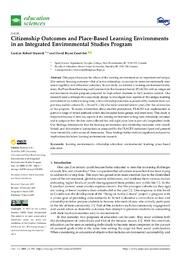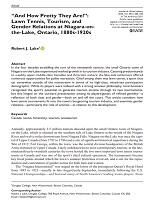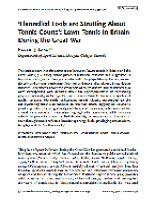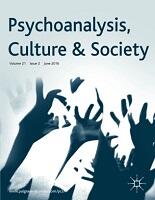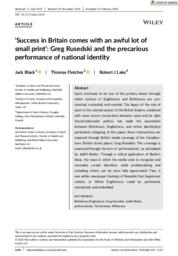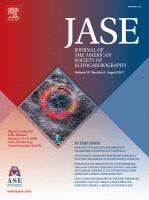Sport Science
Related Works
Content type
Digital Document
Abstract
This paper discusses the effects of the learning environment on an important and unique 21st century learning outcome—that of active citizenship, in contrast to more conventionally measured cognitive and attitudinal outcomes. In our study, we utilized a learning environment instrument, the Place-Based Learning and Constructivist Environment Survey (PLACES) with an integrated environmental studies program prepared for high school students in the Canadian context. Our research used a retrospective case study design to investigate how aspects of this unique learning environment are related to long-term, active citizenship outcomes as perceived by students from two previous student cohorts (N = 24 and N = 36) who were contacted several years after the culmination of the program. To access information about student perceptions, PLACES was implemented as part of a range of mixed methods which also included focus groups and interviews. This study is important because it links key aspects of the learning environment to long-term citizenship outcomes and is unique in that the data were collected five and eight years later as part of a longitudinal study. Our findings demonstrate that the learning environment and citizenship outcomes were closely linked, and that students’ perceptions as measured by the PLACES instrument (past and present) were remarkably stable across all dimensions. These findings further indicate significant and positive implications for future learning environments research.
Origin Information
Content type
Digital Document
Abstract
In the four decades straddling the turn of the nineteenth century, the small Ontario town of Niagara-on-the-Lake experienced marked growth in its tourism industry. Catering predominantly to wealthy upper-middle-class Canadian and American visitors, the lake-side settlement offered numerous opportunities for polite recreation. Chief among them was lawn tennis, a sport that sat somewhat outside of the mainstream in terms of its high-class, mixed-sex participation demographic. While its players were imbued with a strong amateur philosophy, local boosters recognized the sport’s potential to generate tourism income through its two tournaments, but this hinged on the outward presentation among its players/guests of refined gentility—a reflection of both class and gender—both on and off the court. This article considers how lawn tennis tournaments fit into the town’s burgeoning tourism industry, and examines gender relations—particularly the role of women—in relation to this development.
Origin Information
Content type
Digital Document
Abstract
This article examines the connections between (lawn) tennis in Britain and the Great War (1914–1918). While previous historical research has suggested a four-year hiatus, in fact the sport continued to be played during the war, recreationally and among servicemen/women and more elite players in exhibition matches. Anecdotes about the cessation of tournaments and restricted play were interspersed with debates about the appropriateness of continuing play recreationally, as the ‘gentleman in tennis flannels’ became a symbol of public censure. Alongside enlistment, tennis players responded to the call byoffering their club facilities to the war effort, digging up courts to plant vegetables, hosting charity matches, and providing entertainment for convalescent soldiers. This analysis highlights the significance of tennis as a vehicle to promote a kind of British identity, as responses to the war as seen through tennis reflected broader sporting ideals, privileging amateurism, fair play and the ‘stuff upper lip’.
Origin Information
Content type
Digital Document
Abstract
In view of scholarly work that has explored the socio-psycho significance of national performativity, the body and the “other,” this article critically analyses newspaper representations of the Canadian-born British tennis player Greg Rusedski. Drawing on Lacanian interpretations of the body, it illustrates how Rusedski’s media framing centered on a particular feature of his body – his “smile.” In doing so, we detail how Rusedski’s “post-imperial” Otherness – conceived as a form of “extimacy” (extimité) – complicated any clear delineation between “us” and “them,” positing instead a dialectical understanding of the splits, voids and contradictions that underscore the national “us.”
Origin Information
Content type
Digital Document
Abstract
Sport continues to be one of the primary means through which notions of Englishness and Britishness are constructed, contested, and resisted. The legacy of the role of sport in the colonial project of the British Empire, combined with more recent connections between sport and far right fascist/nationalist politics, has made the association between Britishness, Englishness, and ethnic identity(ies) particularly intriguing. In this paper, these intersections are explored through British media coverage of the Canadian-born, British tennis player, Greg Rusedski. This coverage is examined through the lens of ‘performativity,’ as articulated by Judith Butler. Through a critical application of Butler's ideas, the ways in which the media seek to recognise and normalise certain identities, while problematising and excluding others, can be more fully appreciated. Thus, it was within newspaper framings of Rusedski that hegemonic notions of White Englishness could be performed, maintained, and embedded.
Origin Information
Content type
Digital Document
Abstract
<p>Presentation at the <a href="http://www.nasss.org/conference/2015-conference/">North American Society for the Sociology of Sport (NASSS) 36th Annual Conference: Sports at/on the Borderlands: Translations, Transitions, and Transgressions, November 4-7, 2015, Santa Fe, New Mexico.</p>
<p>Aim of the presentation was to analyze the often contradictory social constructions of English and British national identities in tennis, particularly focused on Wimbledon and the All England Lawn Tennis Club.</p>
Origin Information
Content type
Digital Document
Abstract
This study considered how physical education teacher education students "perform" their "selves" within subject department offices during the practicum or "teaching practice". The research was framed by a conceptual framework informed by the work of Goffman on "performance" and "front". The findings revealed three common performances across the whole group across all sites. These were: performance of sports talk, bodily performances, and performance of masculine repertoires. Such performances were considered to be inconsistent with the coursework ideals and principles within the teacher education programme but in step with the general ethos of most PE department offices.
Origin Information
Content type
Digital Document
Abstract
Implementing an effective mental skills training program can be a daunting task. Often coaches do not have the luxury of hiring a sport psychologist or mental trainer to develop and implement their program. Coaches considering developing their own program are often plagued by questions like: How do I convince athletes that mental training is worthwhile? What elements do I include in the program? How do I encourage and support athletes as they develop their mental skills? This paper attempts to address these questions and to offer coaches some practical strategies and ideas for implementing an effective mental skills training program.
Origin Information
Content type
Digital Document
Abstract
Many coaches develop their skills and expertise through their experiences and by watching other coaches. However, simply acquiring experiences does not guarantee coaching competence. It is the integration of experience and knowledge in a meaningful way that promotes learning and in turn develops expertise. Coaches need to know how to best learn through their experiences. Reflective practice is a major learning tool in this regard.
Origin Information
Content type
Digital Document
Abstract
Background
Stress echocardiography has been advocated for the detection of abnormal myocardial function and unmasking diminished myocardial reserve in pediatric patients. The aim of this study was to create a simplified index of myocardial reserve, derived from the myocardial inotropic response to peak semisupine exercise in healthy children, and illustrate its applicability in a sample of pediatric oncology patients.
Methods
In this prospective analysis, children (7–18 years of age) with normal cardiac structure and function performed semisupine stress echocardiography to volitional fatigue. The quotient of wall stress at peak systole and heart rate–corrected velocity of circumferential fiber shortening were calculated at baseline and at peak exercise, the difference of which was termed the index of myocardial reserve (IMR). The IMR was also calculated in a retrospective sample of pediatric oncology patients with normal resting left ventricular function who had received anthracycline treatment and had performed the same exercise protocol to illustrate utility.
Results
Fifty healthy subjects (mean age, 13.2 ± 2.6 years) and 33 oncology patients (mean age, 12.7 ± 4.0 years) were assessed. In the healthy children at peak exercise, heart rate–corrected velocity of circumferential fiber shortening significantly increased (from 1.17 ± 0.17 to 1.58 ± 0.24 circ · sec−1, P < .001), while the quotient of wall stress at peak systole significantly decreased (from 75.3 ± 17.1 to 55.3 ± 13.8 g · cm−2, P < .001), shifting the plot of the relationship between the two parameters upward and to the left. The mean IMR was −30.8 ± 17.8, and the normal distribution ranged from −4.7 (fifth percentile) to −67.3 (95th percentile). The IMR was abnormal in 10 oncology patients who were treated with anthracyclines.
Conclusions
The authors have developed a novel IMR. Relative to the normal distribution of this IMR in healthy subjects, it is possible to identify patients with abnormal myocardial reserve. Thus, this study demonstrates the application of the IMR to aid in clinical decision making in individual patients.
Origin Information

